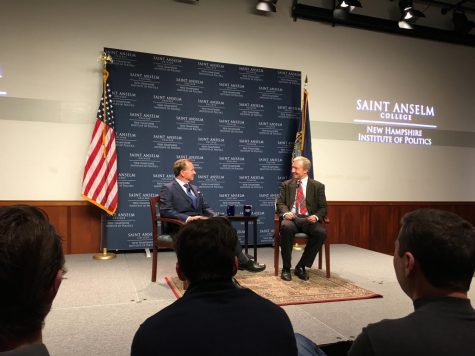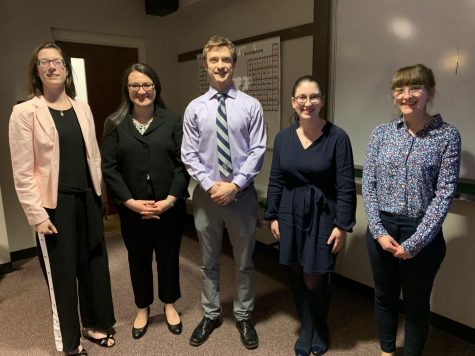Forgiveness and the good of man in Anders Thomas Jensen’s films
November 28, 2018
If you associate Danish film directors with dark, demented movies that are hard to define as horror because of how realistic they can get, it is hard to blame you. Benjamin Christensen helped invent the horror genre with his 1922 witchcraft documentary Häxan (Heksen) and one of the country’s most well-known contemporary directors, Lars von Trier, had around 100 people walk out of the world premiere of his latest film due to its disturbing nature.
The Danish filmmaker I would like to introduce you to does not shy away from the murder and madness that his country has perfected on film, but shows the good in the people who follow wrong paths. Anders Thomas Jensen directs films about many things, but forgiveness is the focus above all others.
Anders Thomas Jensen has contributed most to film as a screenwriter, including work on some English movies like 2008’s The Duchess and 2017’s The Dark Tower.
Like many directors, Jensen began directing with short films that he wrote, leading to his short Election Night (Valgaften) winning the Best Live Action Short Film Oscar in 1999. His feature film directorial debut would arrive the next year.
To date, Jensen has directed four feature films, all of which he has written as well. The first, 2000’s Flickering Lights (Blinkende Lygter), is a good place to start unless you want to save what is possibly the best for last.
Flickering Lights follows four gangsters who decide to run away with the money their boss told them to steal rather than return to him with it and continue their life of crime. While waiting for one of the group to heal from a gunshot wound in a derelict building, the others invest some of the stolen money into disguising their hideout as a restaurant the four are opening.
While reflecting on their childhoods that led the group to a life of crime and to each other, they decide that it might be best to actually open a restaurant and live honest lives. What stands in their way is not just the monumental task of reforming their lifestyle, but also their past catching up with them as their former leader seeks the money that was supposed to be stolen for him.
This first film contains everything you will come to expect from one of Jensen’s: violence, characters with tragic histories, some of the best dark humor put onscreen, a recurring cast of actors, and love for its brutish male leads.
Some of the main characters seem more likely to change their evil ways than others, but I wanted to see each of them succeed. Their changes come not from the circumstances they are under, but the good that is present in every person and gives everyone a chance to be better than they are.
Technically the film is most obviously Jensen’s first attempt at a full-length movie. No part of it is bad, but it does not appear to be under the control of a film master and some musical cues come across as amateurish. The story, however, is moving enough to more than make up for this and the acting is just as superb.
Søren Pilmark stands out as Torkild, the most central of the lead characters, though this would be his only role in the four films I am discussing. Mads Mikkelsen, Nikolaj Lie Kaas, and Ole Thestrup (who passed away this year) would go on to appear in all four, with Mikkelsen getting more important roles as his international fame grew.
Jensen’s second directed film, The Green Butchers (De grønne slagtere), from 2003, is simultaneously the goriest and funniest of the four.
The story follows two butchers who open up their own shop after being fed up with their boss’s abuse, only for nobody to arrive on opening day and their electrician to die after being trapped in the freezer accidentally. When their former boss arrives to gloat and orders meat for a dinner party, one of the butchers sells him cuts from the electrician’s leg as revenge.
The plot does not go according to plan when the human meat is praised by the party’s guests and the butchers need to meet the huge demand for their most popular cut.
The characters in this film are the hardest to find good in, with one of the butchers turning into a murderer and the other trying to distance himself from his mentally handicapped brother who has recently awoken from a coma, not to mention both are turning customers into cannibals.
The characters are more like ordinary people pushed to terrible deeds by tragedy and rejection, and as they get closer to being caught they must get over their pasts to correct themselves.
Again, the film is well made, though it is the most predictable and the most disturbing to look at, with sliced human corpses being moved around on hooks like animal carcasses. Nicholas Bro makes his debut on this list as a minor character, and he would go on to be in the other two films in this overview.
The third film directed by Jensen, 2005’s Adam’s Apples (Adams Æbler), returns closer to Flickering Lights’s theme of criminals finding redemption.
In the film, a neo-Nazi is released from prison to join a rehabilitation program at a church led by an overly optimistic priest. The parolee soon realizes that the priest is unable to recognize any of the terrible things he witnesses, such as the members of his program continuing their criminal ways and his own tragic history.
At first this annoys the neo-Nazi, but he eventually comes to realize that it is only by noticing the good in the world that people can find the good in themselves.
Much of the film is structured around the Book of Job, which a Bible is shown falling open to numerous times. What makes the story interesting is following the twists and revelations to decide which character represents Job, who God plagued with hardships as a test of faith.
This film may be the best of the group from a technical standpoint, with a potent message and refined camera skill. The story and characters are of course still the highlights, with Ulrich Thomsen returning from Flickering Lights to play the main character.
Finally, there is 2015’s Men & Chicken (Mænd og Høns), the most bizarre and unsettling of the four.
This movie centers on two disfigured half-brothers, one scholarly, the other violent, who learn after their father’s death that they were adopted from a reclusive geneticist. The brothers go to their father’s house to learn about him and their mothers. They are greeted by three brothers they did not know they had, who are also disfigured and act violently and primitively.
Because this story is more of a mystery than the others, it is better to know less about the family and the creepy house they share. The setting and pace give Men & Chicken the tenseness of a horror movie at some times, which shows Jensen’s development as a director in evoking feelings from images rather than just dialogue.
Being in a more unfamiliar setting than the other movies, the comedy in this one is more in the characters’ quirks and slapstick fights than in the unusual events Jensen’s characters are usually faced with.
The message that eventually breaks through is that there is value in all human lives, even the ones that come out of the film’s dark plot.
Jensen’s films may be difficult for some to watch based on their violent exteriors, but just like the characters within them, there is a lot of sweetness to be found beneath the surface. Unlike other directors, Jensen does not hide the goodness of his subjects to be dug up after lots of analysis, but makes his message the driving force of each film’s plot.
The world may be filled with evil, but to reject it reveals the good all around us. Even the worst of people have that good somewhere inside them, and Anders Thomas Jensen is making sure we know it one film at a time.








